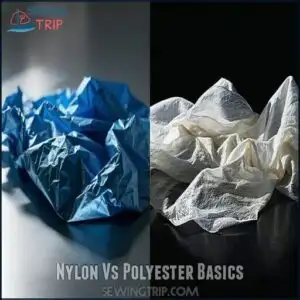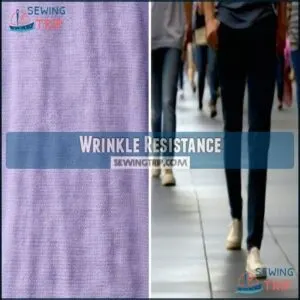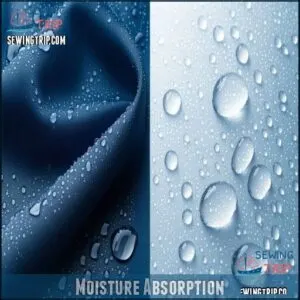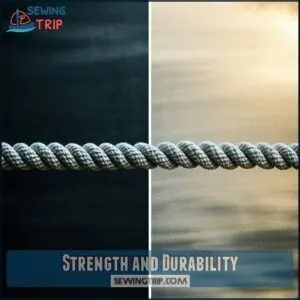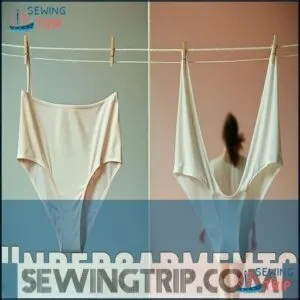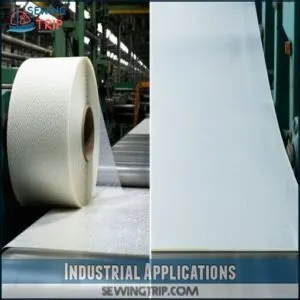This site is supported by our readers. We may earn a commission, at no cost to you, if you purchase through links.

Nylon’s your go-to for durability and strength, perfect for tough outdoor gear that’ll withstand serious wear.
Polyester shines in moisture-wicking and quick-drying performance, making it ideal for athletic wear that keeps you comfortable.
Each fabric has its sweet spot: nylon’s softness and elasticity works great for activewear and climbing gear, while polyester excels in wrinkle resistance and breathability.
Your choice depends on specific needs—whether you’re scaling mountains or running marathons.
Want to know which synthetic superhero fabric will be your performance sidekick? The devil’s in the details.
Table Of Contents
Key Takeaways
- You’ll find nylon excels in durability and strength, making it perfect for tough outdoor gear that needs to withstand serious wear and tear.
- Polyester shines in moisture management, offering quick-drying performance that’ll keep you comfortable during athletic activities and in warm conditions.
- Your choice between these synthetic fabrics depends on specific needs: nylon offers superior elasticity for activewear, while polyester provides excellent wrinkle resistance and breathability.
- Both materials have significant environmental challenges, with neither being fully biodegradable, so you’ll want to consider sustainable alternatives when making your fabric selection.
Nylon Vs Polyester Basics
If you’re curious about synthetic fabrics, nylon and polyester are two powerhouse materials that have revolutionized clothing and industrial applications.
These petroleum-based polymers might seem similar at first glance, but they’ve got distinct characteristics that make them champions in different performance arenas.
History of Nylon
Back in 1935, a breakthrough in synthetic fibers sparked a textile revolution when Wallace Carothers invented nylon at DuPont.
This polymer development transformed fabric manufacturing forever. The discovery of synthetic fibers like nylon also led to comparisons of polyester vs rayon properties in various applications.
| Milestone | Impact |
|---|---|
| 1935 | Nylon Invented |
| 1938 | First Commercial Use |
| 1940 | Women’s Stockings |
| 1941 | Military Applications |
| 1945 | Global Textile Innovation |
Nylon’s journey from laboratory experiment to global textile standard showcases human ingenuity in material science, highlighting the significance of material science in transforming industries.
History of Polyester
After nylon’s groundbreaking invention, polyester emerged as another synthetic polymer marvel.
A textile revolution sparked by science, polyester emerged as a petrochemical wonder that would reshape global manufacturing.
Developed in the United Kingdom during the early 1940s, this petrochemical-based fabric quickly revolutionized textile manufacturing. Its origins traced to Polyethylene Terephthalate (PET), polyester represented a significant leap in synthetic fibers’ fabric evolution.
| Year | Location | Development |
|---|---|---|
| 1940s | UK | First polyester synthetics |
| 1950s | Global | Commercial fabric adoption |
| 1960s | Textile Industry | Widespread manufacturing |
Its journey from laboratory curiosity to global textile staple transformed how modern fabrics are perceived, marking a significant milestone in the evolution of synthetic fibers and textile manufacturing, with polyester becoming a crucial component, and leading to a new era of petrochemical-based fabrics.
Manufacturing Process
Though synthetic materials seem complex, the manufacturing process for nylon and polyester is surprisingly straightforward.
Each begins as tiny plastic pellets transformed through precise polymer formation techniques.
| Stage | Nylon | Polyester |
|---|---|---|
| Raw Materials | Hexamethylene diamine | Mono glycol, PTA |
| Heating Process | Ring-opening polymerization | Chemical reaction |
Textile finishing turns these pellets into strong, versatile fabric threads ready for your next adventure.
Fabric Properties Compared
When choosing between nylon and polyester, you’ll want to understand their unique fabric properties that impact performance and comfort.
These synthetic materials may look similar, but they’ve got distinct characteristics that’ll help you pick the perfect fabric for your specific needs, and understand how they differ in terms of comfort.
Wrinkle Resistance
Ready to conquer wrinkles like a fabric superhero? Polyester and nylon are your trusty sidekicks in the battle against creases.
Their wrinkle resistance is nothing short of impressive, keeping your clothes looking sharp with minimal effort.
- Polyester offers superhuman wrinkle-fighting capabilities
- Nylon maintains smooth appearances in demanding conditions
- Blended fabrics amplify wrinkle resistance
- Minimal ironing needed for these fabric champions
When performance meets style, these materials guarantee you’re always looking crisp and put-together.
Moisture Absorption
Fabric performance hinges on moisture management, where polyester and nylon diverge dramatically.
Your comfort depends on how these materials handle water: polyester’s hydrophobic nature means quick-drying performance, while nylon absorbs moisture more readily.
With polyester’s 0.4% versus nylon’s 4% absorption rate, you’ll feel drier faster in polyester, making it the top choice for active wear and moisture-wicking clothing.
Understanding the benefits of moisture wicking fabrics is essential for selecting the right material for your needs.
Strength and Durability
After wrestling with moisture concerns, your fabric choice now hinges on strength that won’t quit.
Polyester and nylon duke it out in durability’s arena, each packing performance punches:
- Nylon flexes superior tensile strength at 40-100 MPa
- Polyester endures with remarkable tear resistance
- Both materials showcase incredible wear resilience
Whether you’re gearing up for adventure or daily demands, understanding material resistance lets you choose a fabric that’ll go the distance without breaking a sweat.
Apparel Use Comparison
When selecting performance apparel, you’ll want to understand how nylon and polyester tackle different clothing challenges across sportswear, undergarments, and outerwear.
These synthetic fabrics each bring unique strengths to your wardrobe, offering distinct advantages that can make or break your comfort and athletic performance.
Sportswear
Moving from wrinkle resistance to performance, let’s unpack how nylon and polyester compete in athletic wear. Your sports fabric choice matters more than you might think.
| Feature | Nylon | Polyester |
|---|---|---|
| Elasticity | High | Moderate |
| Moisture-Wicking | Good | Excellent |
| Durability | Superior | Reliable |
For athletes, selecting the right nylon sportswear can substantially impact overall comfort and performance. Runners and fitness enthusiasts, your gear’s material can make or break your performance. Choose wisely!
Undergarments
From performance sportswear, we shift our focus to undergarments where fabric choice becomes a skin-deep decision.
Your comfort depends on understanding polyester and nylon’s unique properties.
| Property | Polyester | Nylon |
|---|---|---|
| Breathability | Moderate | Good |
| Moisture Wicking | Excellent | Good |
| Comfort Fit | Tight | Stretchy |
| Skin Health | Quick-Dry | Soft |
| Seamless Design | Consistent | Flexible |
Considering the importance of nylon underwear options, it’s vital to research nylon fabric types when making a decision.
Choose wisely: your underwear’s fabric impacts more than just appearance.
Outerwear
Ever wondered why some windbreakers feel like a second skin while others leave you shivering?
In the context of outerwear, nylon and polyester duke it out for supremacy.
Here’s a quick breakdown of their strengths:
| Material | Waterproofing | Durability | Weight |
|---|---|---|---|
| Nylon | Good | Excellent | Light |
| Polyester | Very Good | Strong | Medium |
Your choice depends on the adventure ahead – each fabric has its moment to shine, considering factors like waterproofing.
Industrial Applications
You’ll find nylon and polyester are industrial workhorses, transforming manufacturing across multiple sectors with their unique performance characteristics.
Whether you’re examining conveyor belts, tire cords, or heavy-duty carpeting, these synthetic materials offer remarkable durability and specialized capabilities that meet increasingly complex industrial demands.
Conveyor Belts
From form-fitting sportswear, we shift gears to industrial powerhouses: conveyor belts. These workhorses rely on smart fabric choices to keep industries rolling.
Your conveyor system’s success hinges on selecting the right materials.
- Polyester guarantees low elongation and fatigue resistance
- Nylon provides exceptional rip strength
- EP (polyester/nylon) blends offer balanced mechanical properties
Maximize your belt’s performance by understanding these critical material dynamics.
Tire Cords
In the context of tire reinforcement, nylon and polyester compete for supremacy in cord materials.
Let’s break down their performance in the rubber domain:
| Property | Nylon | Polyester |
|---|---|---|
| Tensile Strength | High | Moderate |
| Heat Resistance | Lower | Higher |
| Durability | Excellent | Good |
| Weight | Lighter | Slightly Heavier |
| Vehicle Safety | Superior | Reliable |
Your tires’ backbone depends on these synthetic fibers’ incredible strength and resilience.
The use of high quality thread materials is essential in various industrial applications, including tire manufacturing.
Carpeting and Furnishings
From tire durability to home comfort, nylon and polyester tackle home decor with distinct advantages.
Polyester dominates furniture upholstery with its stain resistance and color retention, while nylon leads carpet materials with superior abrasion resistance.
Your flooring and textile finishes depend on these fabrics’ unique properties, offering durable, long-lasting solutions for every home’s style and wear demands.
Nylon carpet products often involve nylon carpet sales to meet various consumer needs, providing long-lasting solutions and superior durability.
Environmental Impact
When you’re evaluating fabrics, understanding their environmental footprint is essential for making responsible choices.
Whether you’re shopping for performance wear or everyday clothing, knowing how nylon and polyester impact our planet can help you make more sustainable decisions.
Biodegradability
At the intersection of fabric science and environmental consciousness, nylon and polyester face scrutiny for their biodegradability challenges.
Here’s what you need to know about their eco footprint:
- Both materials resist natural decomposition
- Nylon takes 30-40 years to break down
- Polyester can persist for 20-200 years
- Microplastic generation remains a critical concern
- Zero complete biodegradation occurs naturally
These synthetic textiles leave a lasting environmental signature, challenging waste management strategies and sustainability efforts.
Recyclability
While biodegradability challenges linger, recyclability offers hope for nylon and polyester fabrics.
Your fabric choice can substantially impact waste reduction strategies. Check out this quick comparison:
| Material | Recycling Efficiency | Closed Loop Potential |
|---|---|---|
| Polyester | High | Excellent |
| Nylon | Moderate | Good |
| Blended Fabrics | Low | Limited |
Sustainable practices are transforming how we view these recyclable materials, turning waste into opportunity. Considering the benefits of biodegradable fabrics can also inform our choices about nylon and polyester.
Eco-Friendly Alternatives
If recycling feels like a small step, eco-friendly alternatives can revolutionize your fabric choices.
Sustainable materials offer powerful solutions for reducing environmental impact:
- Biodegradable polyester options like CiClo transform traditional manufacturing
- Plant-based fibers such as hemp provide remarkable low-waste alternatives
- Recycled synthetic fibers divert waste from landfills and oceans
You’ll find green materials aren’t just responsible—they’re performance powerhouses with a significant environmental impact.
Frequently Asked Questions (FAQs)
Which is better nylon or polyester?
When choosing between nylon and polyester, consider your needs. Nylon’s strength and stretch excel in high-performance gear, while polyester’s durability and color retention shine in everyday clothing and outdoor wear.
Is nylon or polyester better for summer?
You’ll want polyester for summer.
Its moisture-wicking properties and quick-drying nature keep you cool and comfortable.
Lightweight and breathable, polyester shirts and shorts help manage sweat better than nylon during hot, humid days, making them a great choice due to their breathable nature.
Is polyester or nylon more breathable?
Nylon traps more heat and moisture, making it less breathable.
Polyester offers better air circulation, wicking sweat faster and keeping you cooler during summer activities.
Its lightweight, moisture-managing properties give polyester an edge in breathability.
Which jacket is best, polyester or nylon?
Like a knight choosing armor, your jacket depends on your adventure.
Polyester wins for water resistance and affordability, while nylon excels in lightweight durability and breathability.
Consider your specific outdoor needs to make the best choice.
Why is polyester cooler than nylon?
Polyester feels cooler because it wicks moisture faster than nylon, creating a quick-drying surface that reduces heat retention.
Its hydrophobic properties help sweat evaporate more efficiently, keeping you comfortable during active pursuits.
Is nylon stronger than polyester?
Threads of strength dance differently: nylon’s elasticity and tensile prowess outshine polyester’s rigid resilience, giving it a muscular edge in durability and shock absorption across demanding applications.
What is the difference between polyester and polyester?
You can’t have a difference between polyester and polyester since it’s the same material.
It’s like asking how two identical twins differ – they’re basically the same substance with identical chemical properties and manufacturing origins, which makes the concept of difference basically the same as comparing identical things.
What is the difference between polyester & nylon insulation?
With 65% of outdoor gear makers preferring synthetic insulation, you’ll find nylon keeps you warmer while polyester wicks moisture better.
Each material offers unique thermal protection, so choose based on your specific activity and environment, considering synthetic insulation for optimal performance.
Is nylon or polyester better for skin?
In the context of skin comfort, you’ll want to choose polyester.
It’s less likely to irritate sensitive skin, wicks moisture better, and prevents bacterial growth more effectively than nylon’s clingy, less breathable fabric, making polyester a preferable choice for comfort.
Is nylon less toxic than polyester?
Both nylon and polyester contain synthetic chemicals that can be mildly toxic.
However, nylon might release fewer harmful substances during production and use compared to polyester, depending on specific manufacturing processes and treatments.
Conclusion
When choosing between polyester vs nylon, think of them as performance athletes in different events.
Nylon might be the marathon champion, while polyester dominates sprint competitions.
Your fabric selection isn’t just about materials—it’s about matching your specific needs.
Whether you’re designing outdoor gear, crafting athletic wear, or seeking sustainable solutions, understanding each fabric’s unique strengths helps you make an informed decision.
Trust your project requirements to guide your polyester vs nylon selection, and consider the unique properties of each to ensure the best choice for your needs, focusing on the key differences.

